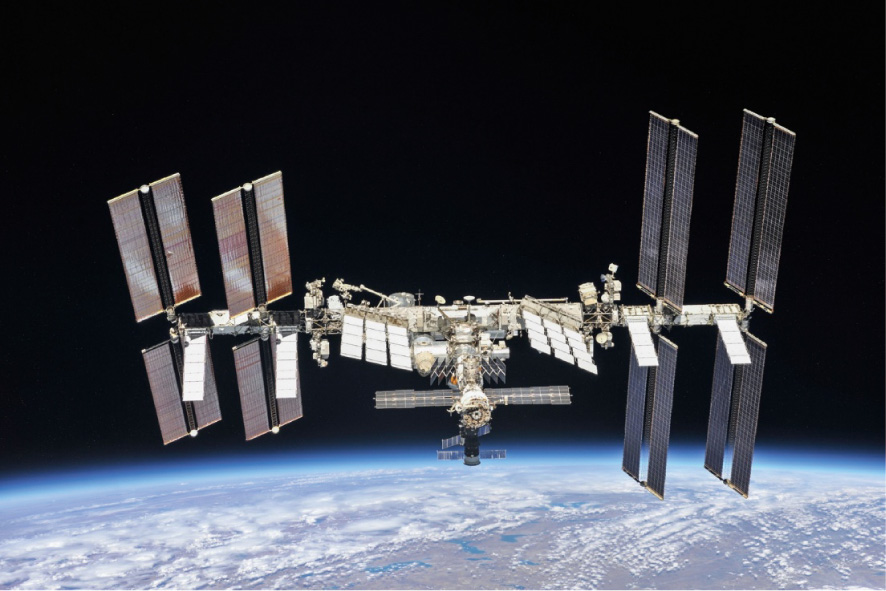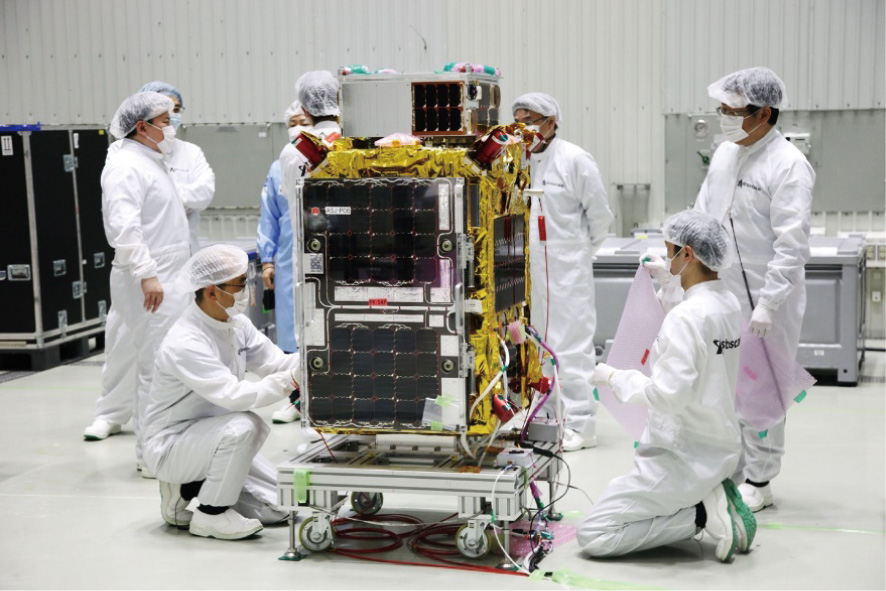On 15 November 2021, a Russian PL19 Nudol interceptor missile took aim at the now-defunct, Soviet-era COSMOS 1408 satellite orbiting at an approximate altitude of 486 km [1]. Hitting its mark, the impact of the missile’s kinetic kill vehicle on the satellite created a massive debris field in low-Earth orbit, triggering an emergency response aboard the International Space Station (ISS) (Fig. 1). With roughly 1500 pieces of trackable objects detected in the two months following the test and likely hundreds of thousands of untrackable smaller pieces, the debris continues to pose a significant risk to space operations and human spaceflight. It also adds to the swelling portfolio of space debris. Despite threatening to make orbits dangerous and unpredictable in the coming decades, the space debris problem is only beginning to be addressed by leading space agencies’ support of remediation technologies [2].
《Fig. 1》

Fig. 1. Debris generated from the collision between a Russian anti-satellite missile and a Soviet-era satellite triggered an emergency response aboard the ISS, shown here in an artist’s depiction, with the seven astronauts living in the station sheltering in a pair of attached spacecraft for 2 h. Credit: NASA (public domain).
‘‘Because of this event, there are likely thousands of operational satellites where the probability of collision has now more than doubled, and it will be more than doubled for years,” said Darren McKnight, a senior technical fellow at LeoLabs, a Menlo Park, CA, USA-based company that tracks space junk.
Looming dangerously close to the ISS in its orbit at 410 km, the debris created by the Russian test forced the seven astronauts living on the ISS at the time, including two Russian cosmonauts, to take shelter for 2 h in a pair of attached spacecraft capable of reentering Earth’s atmosphere and carrying crews back to Earth—a SpaceX Crew Dragon capsule and a Russian Soyuz capsule [1]. The incident may have also threatened the three taikonauts aboard China’s Tiangong Space Station [1], which orbits at 390 km.
While the Russian Foreign Ministry claimed the test did not violate the 1967 Outer Space Treaty and insisted the debris did not pose a hazard to space activity [3], administrators at the US National Aeronautics and Space Administration (NASA) called the action dangerous and irresponsible [1]. US Department of Defense officials additionally called for a global halt to anti-satellite weapons testing [4]. Others objecting to the test included officials in Australia, France, Germany, Japan, Republic of Korea, and at the North Atlantic Treaty Organization [5–10].
A large amount of space debris has been generated by such tests, including one in 2007 in which China fired a missile at an old Fengyun 1C weather satellite [11]. The United States conducted its most recent anti-satellite test in 2008, creating an orbital cloud of about 175 pieces, all of which have since fallen out of orbit [11]. An Indian test in 2019 produced about 130 debris chunks, of which two remain in orbit [11]. Altogether, Brian Weeden, director of program planning at the Secure World Foundation, a Washington, DCbased think tank focused on space sustainability issues, estimates about 6700 pieces of trackable debris have been created through anti-satellite testing since 1959, with about 3800 pieces still in orbit. Weeden said that a handful of countries, including France, Israel, Japan, and the United Kingdom, likely have anti-satellite capabilities but have not conducted any live tests.
‘‘There is some suspicion that Russia sensed growing international pressure to ban these tests, and they wanted to get theirs out of the way,” said Weeden. He added that he expected ‘‘at least a few countries to raise the question of prohibiting this type of destructive anti-satellite test” at the mid-February 2022 meeting of the UN General Assembly’s Open-Ended Working Group scheduled to discuss threats to space activity.
Anti-satellite tests are not the only source of debris in space— castoff rocket boosters and defunct satellites are continually adding to the glut of space trash [2]. Experts also worry about the risks posed by the plans of private companies, including Starlink (Redmond, WA, USA), OneWeb (London, UK), and Amazon (Seattle, WA, USA), to launch up to 65 000 satellites in the next several years to create ‘‘megaconstellations” that will beam high-speed internet service down to Earth [12].
The US Department of Defense currently tracks 27 000 debris shards in orbit [13], while millions of untrackable fragments of junk smaller than 10 cm across continue to orbit as well. ‘‘The space junk problem is serious but not yet catastrophic,” said Jonathan McDowell, an astrophysicist at the Harvard–Smithsonian Center for Astrophysics in Cambridge, MA, USA. ‘‘It is like climate change where you can see it happening. We see it going as per prediction, and not much is being done about it.”
Government officials have been aware of the issue since at least 1978 when NASA scientist Donald Kessler postulated a potentially dangerous cascade of satellites or other orbit-bound objects colliding and creating yet more potentially damaging debris [2,14]. In 1995, nearly two decades later, NASA issued the first comprehensive set of orbital debris mitigation guidelines [15]. The United Nations issued its own mitigation recommendations in 2002 [16]. Until the past few years, however, these and similar efforts have mostly focused on preventing additional objects, including new satellites, from further polluting orbits, and not on removing what is already there. But the reality, McDowell said, is that ‘‘any country can launch as many satellites as it likes, into any orbit, including one that is already densely occupied.”
Among the largest investments in space debris removal technology, with 300 million USD in backing to date, is Astroscale, a Tokyo-based startup jointly funded by the United Kingdom and Japan. In March 2021, the company launched the End-of-Life Services by Astroscale demonstration (ELSA-d) (Fig. 2) [17]. The project utilizes two spacecraft, a 175 kg, mini-refrigerator-sized servicing satellite armed with a magnet and a second smaller 3 kg client satellite. ELSA-d will test the ability of the bigger satellite to chase and magnetically capture the smaller one. While ELSAd successfully released its client in January 2022, Astroscale has reported that ‘‘anomalies” have prevented its capture [18]. Should the planned pair of tests be completed, the two spacecraft will enter a joint orbit and harmlessly burn up in the Earth’s atmosphere.
《Fig. 2》

Fig. 2. Astroscale’s space debris removal spacecraft, shown here, consists of a 175 kg, mini-fridge-sized servicing satellite armed with a magnet and a second smaller 3 kg client satellite perched on top. The project aims to test the ability of the bigger satellite to chase and magnetically capture the smaller one. Once conjoined, the two satellites will eventually deorbit and harmlessly burn up in the Earth’s atmosphere. Credit: Astroscale (public domain).
Astroscale has plans for a second mission in 2023 to grab a Japanese upper-stage rocket booster [19]. But Astroscale’s debris-clearing solution will not work with existing defunct satellites; it will require satellite operators to attach a magnetic plate to their future spacecraft. Satellite internet provider OneWeb is the first company to agree to use the magnetic plates on its fleet of satellites, several of which launched in October 2021 [20]. First up for removal could be a OneWeb satellite that failed in November 2021 [21].
In May 2021, the European Space Agency (ESA) enlisted Swiss startup ClearSpace (Renes, Switzerland) to reel in a 2.4 m, cone-shaped adapter section from an ESA Vega rocket that has lingered in orbit since 2013 [22]. Scheduled to launch in 2025, the company’s ClearSpace-1 will attempt to snag the Vega debris with a set of four robotic arms and then carry it into the atmosphere where both objects will quickly disintegrate (Fig. 3). ClearSpace says its future missions will involve spacecraft that can move up and down in orbit, pulling multiple pieces of debris out of harm’s way [22].
《Fig. 3》

Fig. 3. As shown in this artist’s illustration, the ClearSpace-1 debris removal spacecraft will use its four robotic arms to snag a cone-shaped piece of debris from an ESA Vega rocket, and then escort it into the atmosphere where both objects will disintegrate. Credit: Wikimedia Commons (CC BY-SA 4.0).
While Astroscale and ClearSpace aim to remove debris, others are addressing the problem by developing technology to rejuvenate aging satellites. For example, set to launch in 2025, NASA’s On-orbit Servicing, Assembly, and Manufacturing 1 (OSAM-1) mission will attempt to cut a hole in a US-owned satellite and refill it with hydrazine fuel [23]. Once refueled, the satellite can be controlled from the ground and maneuvered to a safer orbit. Defense contractor Northrop Grumman (Falls Church, VA, USA) is already commercially servicing ailing satellites with its mission extension vehicle (MEV). In September 2021, two MEVs clamped onto two Intelsat satellites, providing the control and power necessary for them to maintain their orbital position [24]. Next, in 2024, the company has plans to use MEVs with Defense Advanced Research Projects Agency (DARPA)-developed robotic arms to attach propulsion jetpacks to six dying satellites, allowing them to maintain their orbits for an additional six years [24].
China has also joined in remediation efforts. In January 2022, China’s Shijian-21 Spacecraft, launched four months earlier, appeared to pull one of its dead Beidou G2 navigation satellites into a ‘‘graveyard orbit” [25].
While ELSA, MEV, Shijian, and other remediation projects seem benevolent in intent, some experts have observed that the same technology could also be used to attack satellites, McDowell said. This potential poses challenges to widespread adoption, as it can raise suspicions that anti-satellite weapons are being tested under the guise of debris remediation. Regardless, McDowell sees technical, legal, and financial obstacles that will need to be overcome before remediation becomes more widely practiced. ‘‘The legal one is big because all this space debris is still owned, both legally and liability-wise, by the launching state,” he said. ‘‘You cannot just go up and grab a piece of debris. You need permission.”
The financial roadblocks are also daunting. ‘‘How do you pay for it?” McDowell asked. ‘‘It has got to come out of taxes in some form, possibly from current space users.” But is it fair, he said, to ask companies like Starlink, which have built in advanced collision avoidance systems and formed plans for safely disposing of satellites once their operational life ends, to pay for the laissez-faire attitudes that superpowers like the United States and Soviet Union had toward mitigation during the first half century of the Space Age.
And despite the recent successful demonstrations, space debris remediation remains a low priority issue for policymakers. ‘‘What we have is a failure to communicate the urgency,” McKnight said. ‘‘There are a lot of people who basically are studying, waiting, and hoping that we will not have to spend any money to get out of this mess. We may have already waited too long.”
As for the ISS, which is still receiving collision avoidance warnings triggered by scraps of COSMOS 1408, NASA recently announced it has no intention of letting the station clog up its orbit once it becomes inoperative. The agency plans to retire the 23- year-old space station no later than 2031 by crashing it into the Pacific Ocean [26].













 京公网安备 11010502051620号
京公网安备 11010502051620号




